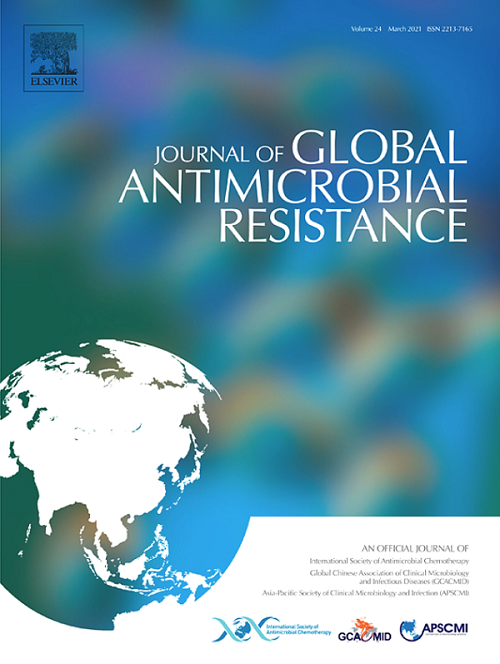日本北部血液感染的甲氧西林敏感/耐药金黄色葡萄球菌(MSSA/MRSA)的分子特征:CC1-MRSA-IV的优势,人类相关ST398和牲畜相关CC20和CC97 MSSA的出现。
IF 3.7
3区 医学
Q2 INFECTIOUS DISEASES
引用次数: 0
摘要
目的:金黄色葡萄球菌是血流感染的主要原因。对日本北部地区耐甲氧西林和敏感金黄色葡萄球菌(MRSA/MSSA)近期流行病学特征及耐药性趋势进行了分析。方法:对血培养金黄色葡萄球菌进行MALDI-TOF筛选,采用MLST型、coa型、agr型、spa型和SCCmec型进行分型。采用多重/单重PCR检测耐药基因和毒力因子。采用肉汤微量稀释试验检测药敏。结果:2023年(4 - 12月)血液感染共分离到301株,其中MRSA 163株,MSSA 138株。MRSA分离株分为CC1-SCCmec-IV (CC1-IV)(52%)、CC5-II(36%)和CC8-IV(12%) 3组。CC1的患病率明显高于我们之前的研究(2017-2021)。4株在ΦSa2usa上携带PVL基因的CC8-IVa分离株被认为是USA300克隆(ST8/spa-t008/coa IIIa/agr I)或其基因型与ST8/t008密切相关或缺乏ACME的变体。相比之下,MSSA在遗传上高度分化,可分为22个STs,其中CC1 (ST1, ST188)最为常见(25%)。值得注意的是,29株MSSA分离株(21%)被划分为家畜相关(LA)基因型、ST20、ST97和CC398 (ST398、ST291)。CC398分离株的遗传特征表明它们属于人类适应的MSSA克隆。结论:本研究揭示了CC1 MRSA超过CC5的增长趋势,并且在日本血液感染中出现了代表人类适应的CC398、LA型ST97和ST20的MSSA。本文章由计算机程序翻译,如有差异,请以英文原文为准。
Molecular characterization of methicillin-susceptible/resistant Staphylococcus aureus from bloodstream infections in northern Japan: The dominance of CC1-MRSA-IV, the emergence of human-associated ST398 and livestock-associated CC20 and CC97 MSSA
Objectives
Staphylococcus aureus (S. aureus) is a major cause of bloodstream infections. The recent epidemiological features and antimicrobial resistance trend were analysed for methicillin-resistant and susceptible S. aureus (MRSA/MSSA) isolates from blood samples in people from northern Japan.
Methods
The S. aureus isolates from blood culture were screened by matrix-assisted laser desorption ionization-time of flight (MALDI-TOF) and genotyped by the schemes of multilocus sequence typing (MLST), coa, agr, spa, and SCCmec types. Antimicrobial resistance genes and virulence factors were detected by multiplex/uniplex polymerase chain reaction (PCR). Antimicrobial susceptibility was examined using a broth microdilution test.
Results
A total of 301 isolates (163 MRSA and 138 MSSA) were isolated from bloodstream infections in 2023 (from April to December). The MRSA isolates were classified into three groups, that is, clonal complexes (CC)1-SCCmec-IV (CC1-IV) (52%), CC5-II (36%), and CC8-IV (12%). The prevalence of CC1 was significantly higher than those in our previous studies (2017–2021). Four CC8-IVa isolates with PVL genes on ΦSa2usa were considered to be the USA300 clone (sequence type [ST]8/spa-t008/coa IIIa/agr I) or its variants that were genotyped as those closely related to ST8/t008 or lacking arginine catabolic mobile element (ACME). In contrast, MSSA was genetically highly divergent and classified into 22 STs, with CC1 (ST1 and ST188) being the most common (25%). It was notable that 29 MSSA isolates (21%) were classified into livestock-associated (LA) genotypes, ST20, ST97, and CC398 (ST398 and ST291). Genetic characterization of the CC398 isolates suggested that these belong to human-adapted MSSA clones.
Conclusions
The present study revealed the increasing trend of CC1 MRSA surpassing CC5, and the emergence of MSSA representing human-adapted CC398, and LA types ST97 and ST20 from bloodstream infections in people in Japan. © 2024 The Author(s). Published by Elsevier Ltd on behalf of International Society for Antimicrobial Chemotherapy.
求助全文
通过发布文献求助,成功后即可免费获取论文全文。
去求助
来源期刊

Journal of global antimicrobial resistance
INFECTIOUS DISEASES-PHARMACOLOGY & PHARMACY
CiteScore
8.70
自引率
2.20%
发文量
285
审稿时长
34 weeks
期刊介绍:
The Journal of Global Antimicrobial Resistance (JGAR) is a quarterly online journal run by an international Editorial Board that focuses on the global spread of antibiotic-resistant microbes.
JGAR is a dedicated journal for all professionals working in research, health care, the environment and animal infection control, aiming to track the resistance threat worldwide and provides a single voice devoted to antimicrobial resistance (AMR).
Featuring peer-reviewed and up to date research articles, reviews, short notes and hot topics JGAR covers the key topics related to antibacterial, antiviral, antifungal and antiparasitic resistance.
 求助内容:
求助内容: 应助结果提醒方式:
应助结果提醒方式:


